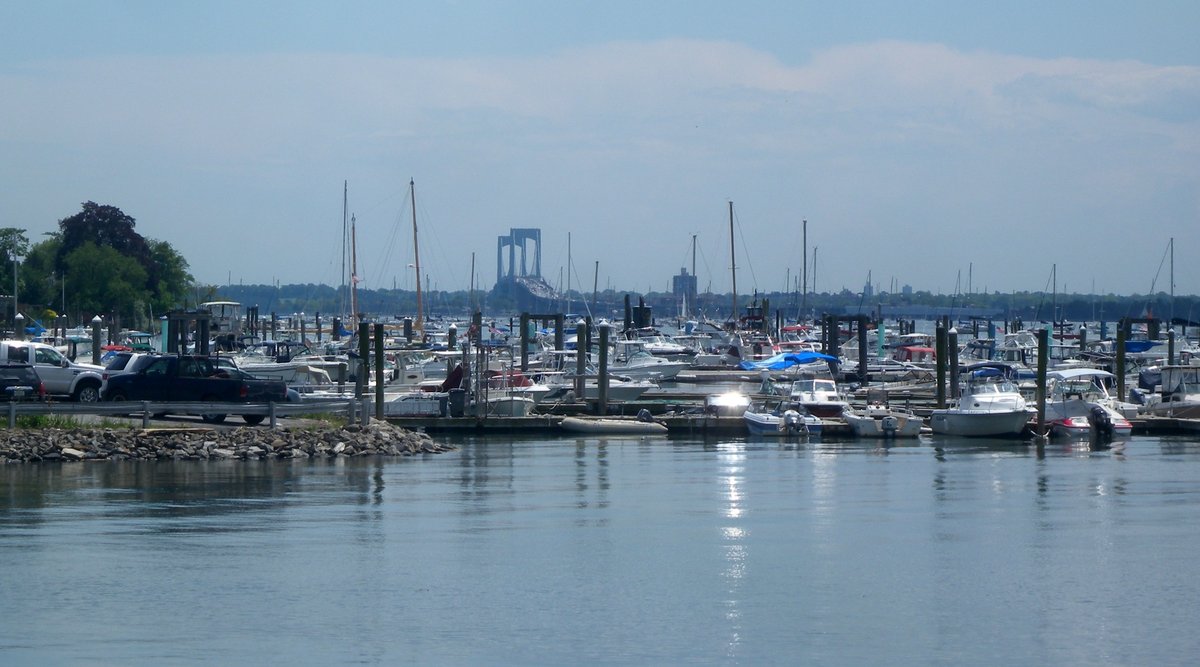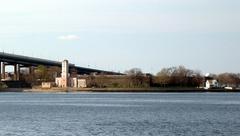
Throgs Neck Bridge Visiting Hours, Tickets, and Travel Guide – New York City
Date: 14/06/2025
Introduction: Discovering the Throgs Neck Bridge
The Throgs Neck Bridge is a defining feature of New York City’s landscape, serving as a critical suspension bridge that connects the Bronx and Queens across the East River. Opened in 1961, this engineering marvel was designed by Othmar Ammann to alleviate traffic congestion and is managed as part of the city’s extensive transportation network. While the bridge is reserved exclusively for vehicular traffic and does not accommodate pedestrians or cyclists, its striking silhouette, historical importance, and panoramic views make it a point of interest for both locals and visitors. This guide provides detailed information about the bridge’s history, access, viewing spots, travel tips, nearby attractions, and practical advice for making the most of your visit.
Contents Overview
- Introduction
- History of the Throgs Neck Bridge
- Visiting Information (Access, Hours, Toll, Accessibility)
- Travel Tips and Best Viewing Spots
- Nearby Attractions
- Frequently Asked Questions (FAQ)
- Practical Visitor Advice
- Conclusion
The History of the Throgs Neck Bridge
Origins and Naming
The bridge draws its name from the Throgs Neck peninsula, a historically significant area at the confluence of the East River and Long Island Sound. This peninsula was named after John Throckmorton, an early English settler, with the spelling later streamlined to “Throgs Neck” for signage efficiency during the bridge’s planning phase.
Planning, Construction, and Impact
Post-World War II, New York City faced surging automobile traffic, especially on the Bronx–Whitestone Bridge. Urban planner Robert Moses and engineer Othmar Ammann spearheaded the Throgs Neck Bridge project to relieve congestion and enhance connectivity between the Bronx, Queens, and Long Island. Construction began in the late 1950s, and the bridge officially opened in 1961. With its six lanes and elegant light-blue steel towers, the Throgs Neck Bridge quickly became a vital transportation link, supporting tens of thousands of vehicles daily (cityneighborhoods.nyc).
Beyond its transport function, the bridge spurred suburban growth, increased property values, and cemented its status as an iconic city landmark (thesciencesurvey.com).
Visitor Information: Access, Hours, and Tolls
Can You Visit or Walk Across the Throgs Neck Bridge?
No. The bridge is strictly for motor vehicles; pedestrians and cyclists are not permitted due to safety concerns. However, visitors can admire and photograph the bridge from several nearby parks and waterfronts.
Visiting Hours and Vehicle Access
- Hours: The bridge is open 24/7 for vehicular traffic.
- Pedestrian/Bicycle Access: Not available.
- Tickets: No ticketing system for vehicles; tolls are collected electronically for eastbound (Bronx-to-Queens) travel.
Toll and Payment Information
- Tolls: Eastbound only (from the Bronx into Queens).
- Payment Methods: E-ZPass and toll-by-mail.
- Check current rates: MTA Bridges and Tunnels
Accessibility
While the bridge itself is not accessible to pedestrians, surrounding parks such as Ferry Point Park (Bronx) and Little Bay Park (Queens) are wheelchair- and stroller-friendly and offer excellent views.
Public Transportation
- Subway: No stations directly adjacent; nearest stops are several miles away.
- Bus: MTA bus routes serve neighborhoods near both ends of the bridge.
- Ferry: NYC Ferry’s Soundview route stops at Ferry Point Park (citysignal.com).
- Taxis/Rideshare: Practical options for direct access to viewing areas.
Best Viewing Spots and Photography Tips
The best ways to appreciate the Throgs Neck Bridge’s grandeur are from public parks and waterfronts:
- Ferry Point Park (Bronx): Expansive lawns, picnic areas, and waterfront trails make it ideal for photos, especially at sunrise or sunset.
- Little Bay Park (Queens): Walking trails and open spaces offer unobstructed views of the bridge’s towers and cables.
- Fort Totten Park (Queens): Historic site with scenic vantage points.
- Shore Road & Cross Island Parkway: Both provide scenic drives with intermittent bridge views.
Photography Tips:
- Golden hour (early morning or late afternoon) offers the best natural lighting.
- Nighttime captures the bridge’s illumination.
- Drone use is generally prohibited due to city regulations (NYC Parks Drone Policy).
Nearby Attractions
- SUNY Maritime College: Located near the Bronx approach, featuring maritime exhibits and events.
- Fort Totten Park: Historic Civil War fort with walking trails and waterfront vistas.
- City Island: Renowned for its seafood restaurants and nautical charm.
- Bayside Marina (Queens): Offers boating, fishing, and waterfront dining.
Practical Tips for Your Visit
- Driving: Off-peak hours (midday, late evening, or weekends) are best to avoid traffic congestion.
- Parking: Available at Ferry Point and Little Bay Parks, but may fill up on weekends or during events.
- Amenities: Restrooms and picnic facilities are available in nearby parks—not on the bridge itself.
- Weather: The area is exposed and can be windy; dress accordingly.
- Safety: Never attempt to walk or bike onto the bridge roadway.
Frequently Asked Questions (FAQ)
Q: Can I walk or cycle across the Throgs Neck Bridge?
A: No, the bridge is for vehicles only. Pedestrian and bicycle access is strictly prohibited.
Q: Are there tickets required for crossing or visiting?
A: No tickets are needed to cross by car; tolls are collected electronically for eastbound vehicles.
Q: What are the best spots for photos?
A: Ferry Point Park, Little Bay Park, and Fort Totten Park offer safe, scenic vantage points.
Q: How can I reach the area using public transit?
A: Use MTA buses or the NYC Ferry’s Soundview route to Ferry Point Park.
Q: Are there guided tours?
A: No official bridge tours exist, but local walking tours of Throggs Neck or Bayside may include bridge views.
Q: Is there parking near the viewing areas?
A: Yes, both Ferry Point and Little Bay Parks have parking lots, though they may be full on busy days.
Safety, Community, and Transit Equity
The Throgs Neck Bridge is not only a vital transportation corridor and emergency evacuation route, but it also plays a role in the economic stability and growth of the Throggs Neck and Bayside neighborhoods. Recent expansions in public transit, such as the NYC Ferry, have enhanced accessibility and equity for local communities (citysignal.com).
Seasonal and Local Recommendations
- Best Seasons: Spring and fall for comfortable weather and fewer crowds.
- Community Events: Check Ferry Point and Fort Totten Park calendars for festivals.
- Local Dining: Enjoy seafood on City Island or Italian cuisine in the Throggs Neck neighborhood (thetravel.com).
- Accessibility: Both major viewing parks have paved, accessible paths.
Visuals and Media
- High-quality images of the Throgs Neck Bridge at sunrise, sunset, and night are recommended.
- Include a map showing the bridge and nearby parks.
- For more visuals, visit the NYC Parks website.
Internal Links
Conclusion
The Throgs Neck Bridge is a testament to New York City’s engineering prowess and urban planning, continuing to shape transportation and neighborhood development decades after its construction. While direct pedestrian access is unavailable, the bridge’s grandeur and historical resonance can be fully experienced from nearby parks and neighborhoods. Use public transit or plan a scenic drive, bring your camera, and make the most of the local dining and recreational opportunities. Stay informed by consulting official resources like the MTA Bridges and Tunnels website, and consider using the Audiala app for enriched, self-guided explorations.
Plan your visit to the Throgs Neck Bridge and discover one of New York’s most impressive and important landmarks (cityneighborhoods.nyc, NY Daily News).
Sources and Further Reading
- Metropolitan Transportation Authority (MTA) – Bridges and Tunnels
- NYC Parks
- CityNeighborhoods.nyc – Throggs Neck
- NY Daily News – Bridges to the Past
- Soundview Ferry Expansion – CitySignal.com
- Safest Neighborhoods in NYC – TheTravel.com
- The Globetrotting Teacher – NYC Tips























































































































































































































































































